
Rapid Content Development: Creating E-Learning Trainings Quickly
Why fast creating digital trainings is possible but risky
... and suddenly, the training had to be scrapped. Many companies made that experience in lockdown number one. Employees needed to be trained, but the training was postponed due to Corona. Again. And again. However, most types of training simply cannot be endlessly postponed or even be cancelled altogether.
A pragmatic and swift solution is needed – training needs go where the employees are: their home office. For many companies, that means digitising learning content, and doing so quickly. They need rapid content development. This trend was already apparent before Corona, but the pandemic greatly increased the demand for the technologies that facilitate rapid content development.
This article explores what qualifies as rapid content development, what type of learning content is suitable for rapid digitisation, and what risks a strong focus on speed entails.
INFO
Definition: Rapid content development (RCD) is an agile model for teaching system design, comprising a preparation phase, an iterative design, template-based re-usable components and e-learning tools for quick and cost-efficient provision.
Speedy please – but without quality loss
We want things now: fast food, coffee to go, messenger services, online shopping … we no longer have time. Companies have also clocked onto this trend, and want to stay up to date with their training courses. An ever-increasing amount of knowledge is expected to be available almost instantly on various media while maintaining a high quality standard and staying within budget.
The solution: rapid content development. But wait a minute! No matter how fast you go, the quality of the overall learning solution must not be compromised. That’s why learning experts like Eva Lettenbauer always look at the big picture.

Eva Lettenbauer, Specialist Learning Experience Design at imc
Hi Eva, thanks for “quickly” making time for us. How did you experience the rapid content development hype last year?
Especially at the beginning of the pandemic, many companies were facing the challenge of having to digitalise their face-to-face training in a short space of time. However, directly transitioning classroom-based training courses to a virtual classroom or web session is not always effective, and it’s most certainly not efficient.
That is why we always examine the specific issues and objectives. This allows us to digitise specific learning content in a way that drives outcomes and boosts performance.
How do you handle requests for “rapid” content?
Since requirements differ as widely as the type of knowledge to be conveyed, digital solutions vary enormously. We start by analysing the sharable knowledge and the desired outcome. We also examine if the integration of certain existing learning solutions or curated content would add value, and examine the suitability of different learning infrastructures. Finding the right formats for the content at hand has to be a priority, as this then allows new content to be created quickly and systematically.
What risks does rapid content development involve, and how do you avoid them?
There is a risk of quality loss – creating too much content while neglecting quality, or losing sight of the target group, their performance or the intended business outcome when designing and creating content. This can make the learning solution irrelevant and ineffective. Often, less is more. It pays to take a closer look and be more deliberate when starting the rapid content development process, and avoid such mistakes.

When would you recommend slowing down?
Whenever learning corresponds to behavioural changes, aims to change the learners’ mindset, or the branding, look or feel of the learning solution are important, investing time to achieve a high-quality solution is paramount. This is the only way to gain the learners’ lasting interest and make them believe in digital learning approaches.
GOOD TO KNOW
Authoring tools enable companies to create learning content themselves or digitise existing material. This facilitates a flexible response to learning requirements within the company.
Authoring tools are cost-effective and allow both internal experts and other employees to create training courses. This is also known as user generated content.
What are the limits for content creation with authoring tools?
Authoring tools like imcExpress are ideal for quickly creating and sharing content based on facts or background knowledge. Digital learning content can be created quickly and – crucially – kept up to date. However, no learner should be trained exclusively with web-based training courses. Especially if their development involves the application of specific practical skills, traditional web-based training is seldom enough – but that is all an authoring tool can deliver.
What would a worst-case scenario look like? How “not to” do it?
Worst case: 5 days of face-to-face classroom training is taken “as is” and squeezed into a 3-day training course in a virtual classroom. Endless recordings of face-to-face training or web sessions replace the on-site presentation of the material.
Best case: A 3-day face-to-face training course is digitalised and broken up into various learning nuggets like short web-based training courses, complemented with learning tandems, snappy web sessions and curated content.
How about a quick summary? Happy to be at your service:
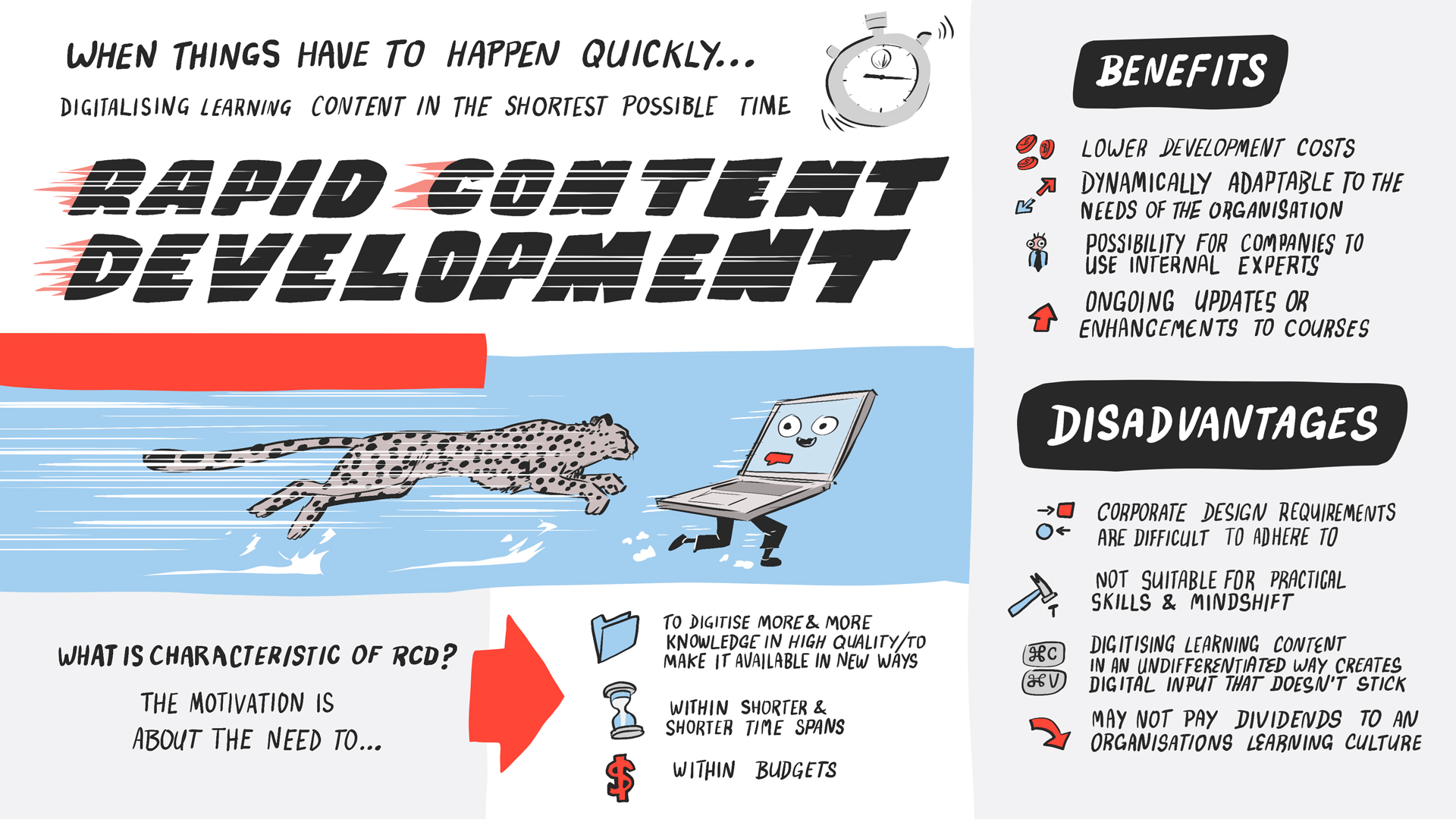

Digital Learning Journey
Reaching the destination with the right blend of formats: Digital learning journeys capitalise on the strengths of each learning format to create a motivating learning experience.

User-generated elearning content meets artificial intelligence
Creating learning content has nerver been that easy. Oliver Nussbaum and his team developed a new AI-driven authoring tool called imc Express.
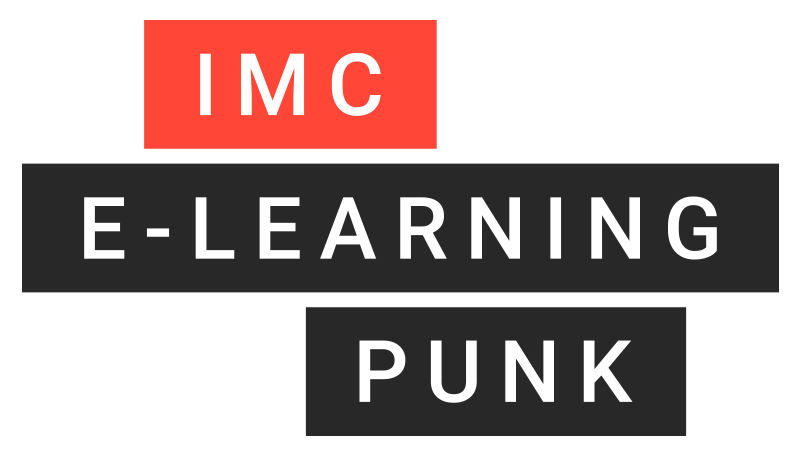
Contact person
I joined the imc newsroom team in 2021. As a journalist my heart beats for content and storytelling.
I’m excited to figure out how e-learing and digitization affect the future of work. My task is to create content to talk about and I’m always looking for trends.
Privately I love to travel and eat Tapas.
Topics: E-Learning Trends, Corporate Social Responsibility, Press and Influencer Relations

The Ultimate Benefits of an LMS and an LXP Integration
Combining the best of two worlds: Why LMS and LXP will merge into integrated platforms

There is a massive but fragmented market for training and learning tools in this new decade, with more than 30 Learning Experience Portal (LXP) vendors, 200 LMS vendors, and thousands more who specialise in creating various tools.
Collaboration, content development, analytics and mobile learning are the main purposes of these tools [Source: Josh Bersin Academy]. Moreover, these vendors are beginning to take note of a trend towards integrated platforms to benefits companies.

LXP: The new kind of product?
An LXP’s purpose is to improve self-directed learning and give learners control over their decision making in their own learning. However, it doesn't acknowledge the importance of the organisation and its corporate goals.
Josh Bersin defined the term “Learning Experience Portal” several years ago as a new type of product. In this portal, the learners understand the objective of their learning “in a workflow" defined by them.
However, why should we consider a new category when the term Learning Management System (LMS) subsumes all forms of teaching and learning? We must remember that LMS were originally designed to enable the “management” of learning only. They concentrate on:
- Business processes,
- Control of learning processes (such as adherence to compliance requirements),
- The provision of catalogues, and
- The corresponding evaluation options for an organisation.
Learner engagement, adaptive learning and AI
On the other hand, engaging learners is an LXP's objective. The LXP is partly mapped with self-directed learning through the integration of competence-based methods. If the target group is homogeneous, then we can apply the principle of LXP more successfully.
In the past, Learning Management Systems did not consider self-directed learning in its features. However, this is changing rapidly and learning systems are catching up. This is due to the increasing decoupling of front ends and back ends via corresponding API functionalities. Moreover, innovation cycles are becoming ever faster and interfaces can be individually adapted for each learner group. Eventually, they offer an individual user experience when required.
Additionally, artificial intelligence has become an integral part of almost every solution. This means that topics such as adaptive learning, content curation and personalisation can be found in both worlds. An LMS has all the necessary learning processes that an LXP does not, including regulatory training and on-the-job functionalities. This means that courses and learning processes can be mapped in an integrative interface.
Integrated learning platforms are here to stay
Learning systems must integrate more and more into existing infrastructures. This means that they can also partly give up their own core functionalities. In addition, the latest trend is the integration of different portals with an individual user and learning journeys for different target groups, such as internal employees and external partners. This helps to create the best possible user experience.
Since learning experience portals focus more on the experience aspect, it is becoming more difficult to offer target groups or case-orientated portals.
This is where an LMS has an advantage due to its technological structure. Front ends have traditionally been developed for their back ends to be connected via APIs (e.g. REST API). This provides these learning systems with a powerful tool for integration and interoperability.
Almost by chance, we can set up entire learning ecosystems by developing stable and extensive API management. If we spin this a little further, an Internet-enabled refrigerator today can provide learning content of a product at breakfast.
But LMS and LXP integrations are not only used to provide learning content. Most importantly, comprehensive learning management considers the support of all processes involved. For example, controlling door signs, or confirming seminar participation with an employee magnetic card or scanning a QR code.
In conclusion, the market is heading in this direction, and the trend is very clear: integrated learning platforms are here to stay. Read more about what and how to integrate with an LMS here.
If you are keen to find out what the integration possibilities are for imc's LMS - the imc Learning Suite - go to the imc Learning Suite Integrations and Connectors page.

Learning is more than just an experience
Make the most impact by integrating a learning experience platform (LXP) into a learning management system (LMS).

Gamified Learning to Drive Learner Motivation
Use gamified learning to increase employees' motivation and help them build their skills in the workforce.
![[E-Learning Punk] Exploratory 3D Learning](https://images.im-c.com/wp-content/uploads/2021/02/imc_image_elearningpunk_3Dlearning_hero.jpg)
Exploratory 3D Learning
Spatial depth brings profound changes to the world of professional development

Digital 3D professional development
Maximum educational value x3
- Interactive and exploratory learning in virtual space
- Independent exploration of a visually appealing world
- Experiencing the immediate consequences of actions
Application scenarios for 3D Learning x3
Onboarding
In large corporations, a 3D map can provide initial orientation to the various corporate divisions which are displayed on a kind of city map, for example.
Product training
A 3D map makes it possible to vividly present products and services to clients, partners and employees in virtual showrooms – and not only during lockdown. AR spots make the integration of virtual and physical worlds turn out particularly well.
Security training
3D Map supports efficient training for appropriate behaviour in crisis scenarios such as a fire in the building.
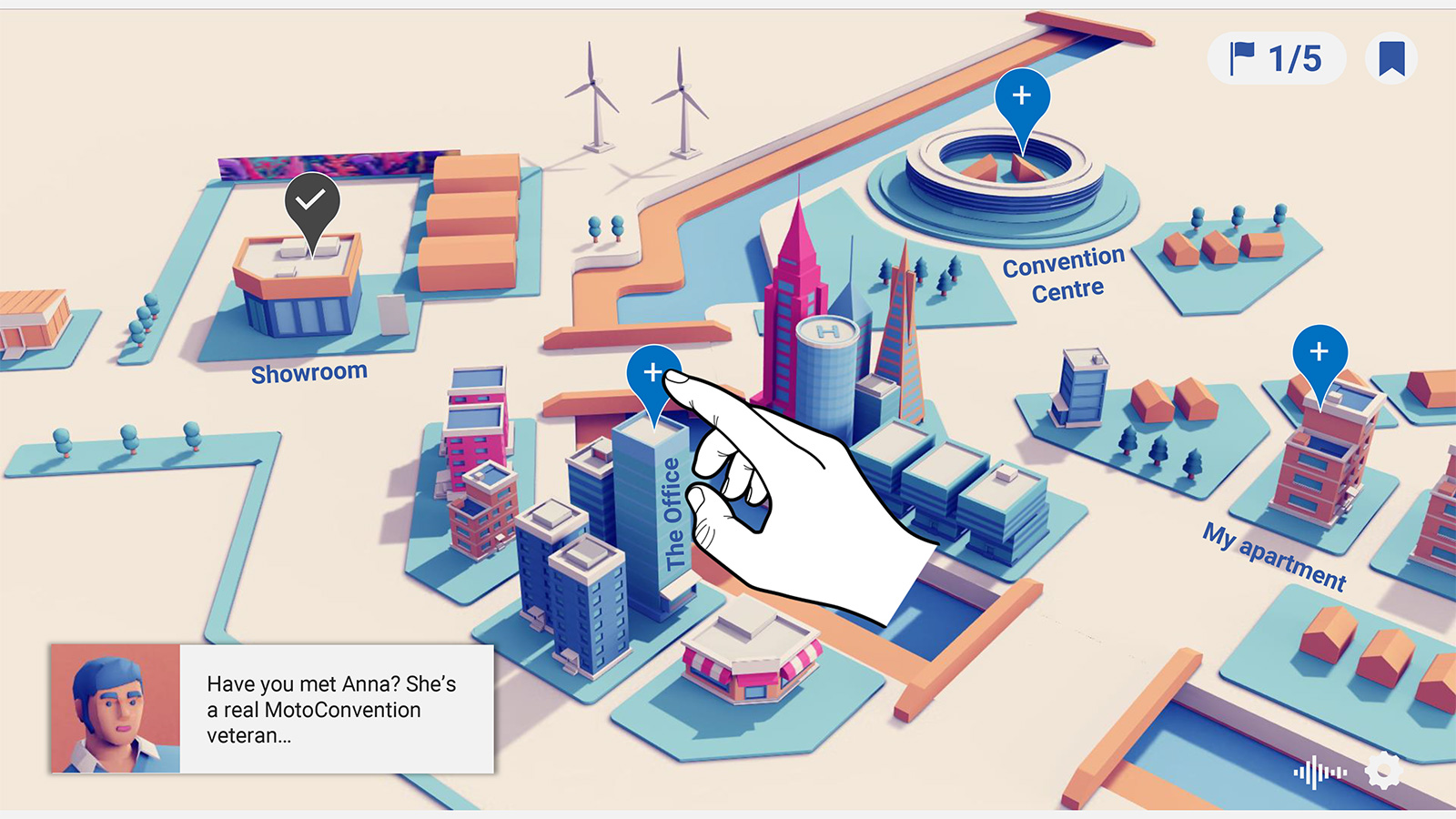
Another concrete example for the use of the imc 3D Map is a virtual world called "Moto City".
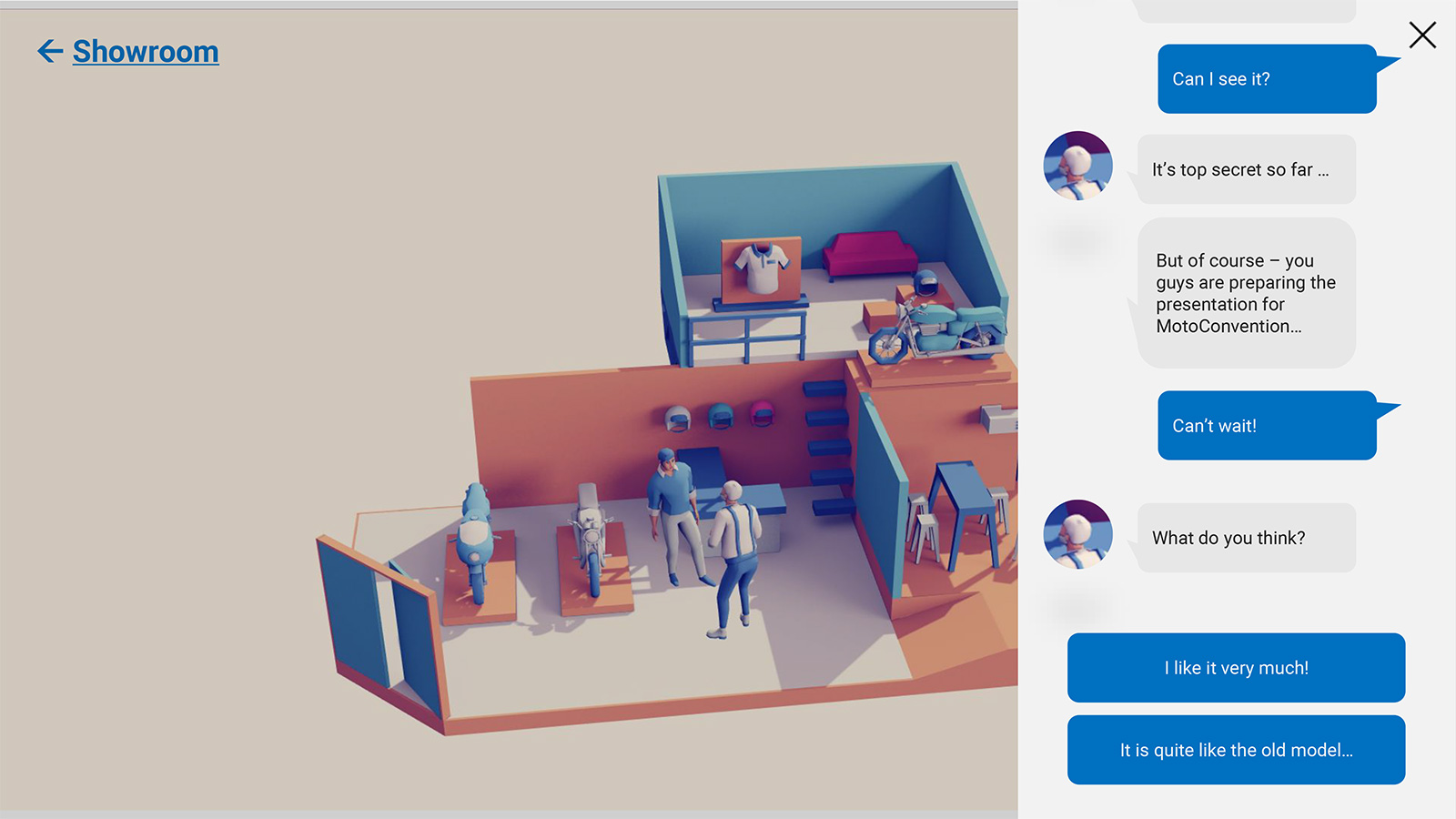
Another concrete example for the use of the imc 3D Map is a virtual world called "Moto City".

Another concrete example for the use of the imc 3D Map is a virtual world called "Moto City".
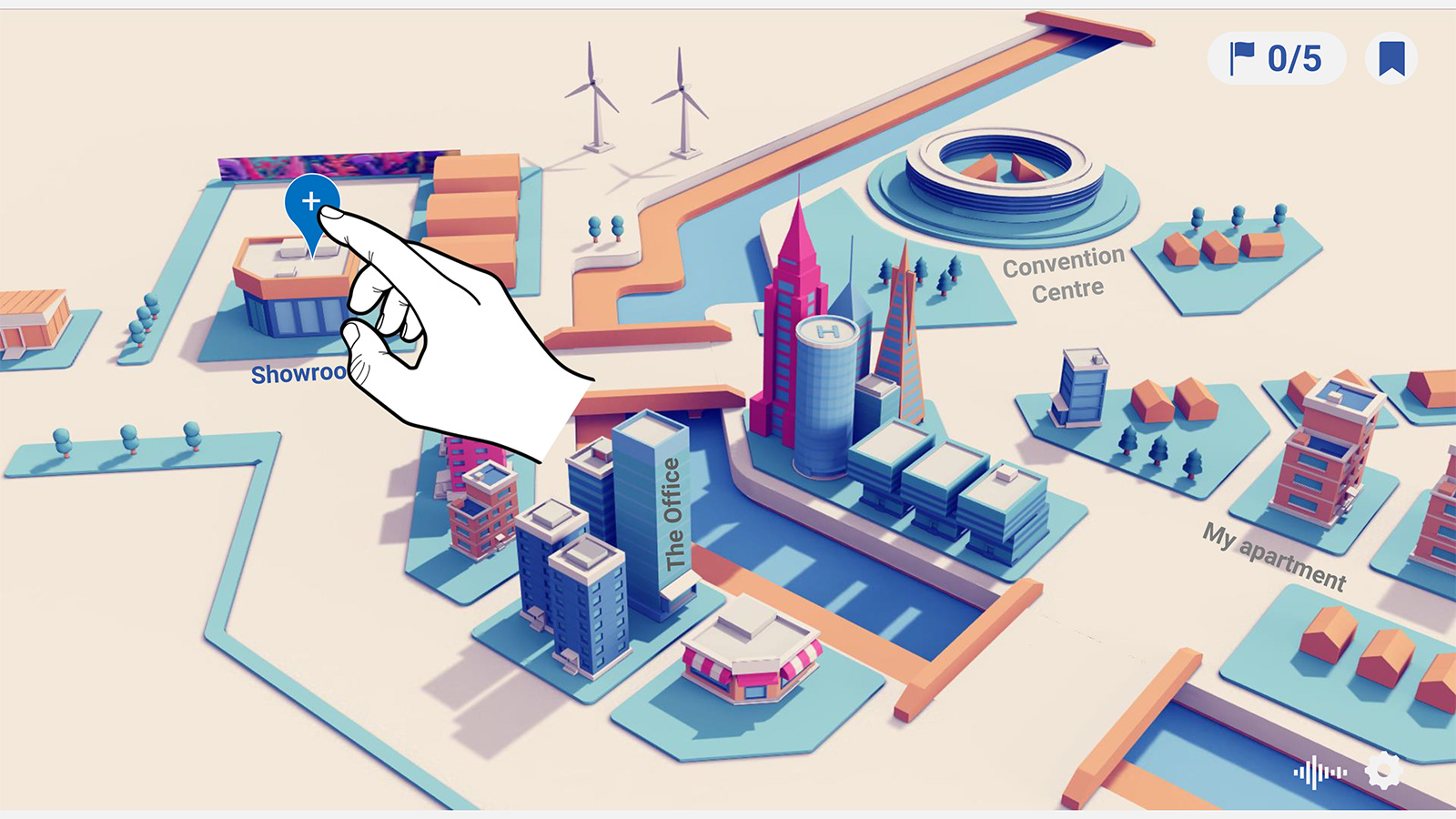
Another concrete example for the use of the imc 3D Map is a virtual world called "Moto City".

Another concrete example for the use of the imc 3D Map is a virtual world called "Moto City".
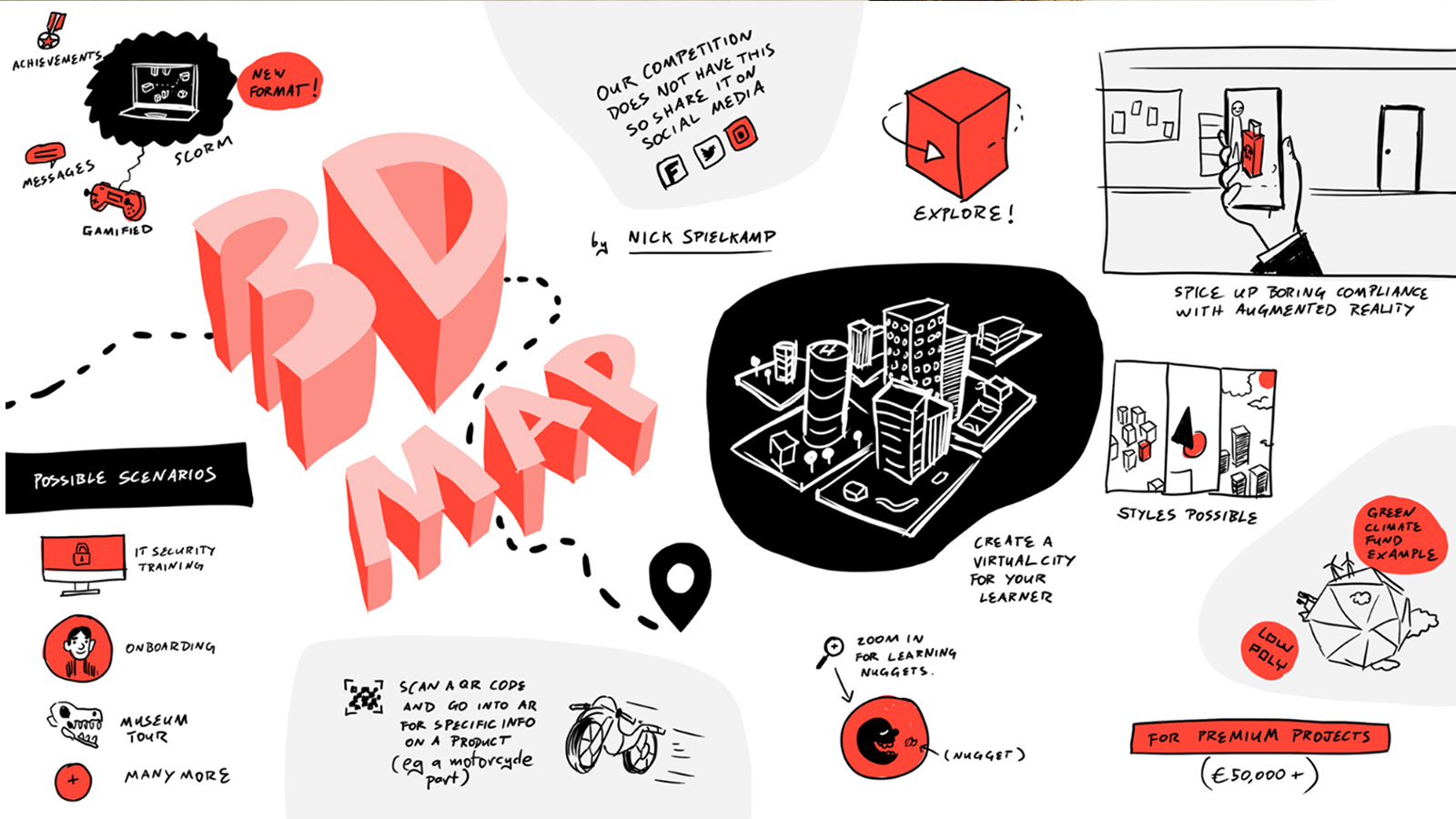

Contact person


Five tips for more fun with e-learning
The company is offering a new e-learning course – does this still have the unfortunate effect of triggering the same feelings in your learners as their annual reminder to have the plaque removed from their teeth? It doesn't have to! We'll give you tips and tricks on how to make learning more fun by using GIFs.
Basics on the topic of GIFs
The first GIF had already been developed as early as 1987, but the idea of GIFs goes back even further. GIFs are, in fact, comparable to the good old flip book. The rapid flow of several individually drawn graphics creates a moving image for the human eye, basically an extremely short video without sound.

Not quite picture, not quite video: GIF stands for Graphic Interchange Format. GIFs are usually animated short clips without sound.
Even after more than 30 years, GIFs still enjoy great popularity, despite their somewhat dated appearance. The popular moving images are widely used, pixelated and limited colour spectrum notwithstanding, because they can be integrated almost anywhere and are easy to create and share. What’s more: Our digital communications, whether on Twitter, WhatsApp or Teams, would certainly be a lot less entertaining and descriptive without GIFs. Speechless? No problem! Joy, sadness, compassion, shame – no matter what feeling you want to convey, you can always find a GIF for it.
Good reasons for using GIFs in learning
Social media is not the only place for GIFs. They can also make learning more vivid and entertaining. We have compiled the most important arguments for the use of GIFs in e-learning for you:
- GIFs visually represent ideas and information in a few seconds
- A GIF is easier to follow than a series of still images
- GIFs usually run in a loop and are also perceived out of the corner of the eye
- GIFs therefore do justice to the attention span of Generation Goldfish (<8 seconds)
- Creating GIFs is much easier than creating high-end video content
- GIFs play automatically on almost any system
- GIFs trigger emotions. The stronger the emotion, the better the memory
- GIFs are mobile-friendly and ideal for micro-learning
tips for more GIF Ingenuity
The use of GIFs in e-learning offers several advantages. Use these short, vivid clips, for example, to make a step-by-step tutorial more entertaining, reinforce a key message, provide feedback, or make comparisons. We have summarised the most important tips for using GIFs in digital training courses for you below:
Tip 1: Offer your goldfish entertainment
Technological progress brings many opportunities and possibilities along with it, but at the same time, it is blamed for decreasing attention spans. You can counter that with GIFs. A good GIF attracts attention and triggers emotions, thus ensuring long-term retention. Boring, colourless GIFs reduce these effects.

Tip 2: No information overload
A rule of thumb should be: Only one theme per GIF. The individual short clips should not be longer than ten seconds and should be intuitively comprehensible. After all, true GIF genius is about explaining even complex facts in a simple and entertaining way (see point 1!).

Tip 3: Don't become Robin Hood. Or: No stealing for a good cause
Besides the popular genre of animal GIFs (keyword cat content), ultra short film scenes make particularly popular GIFs. Before you use a GIF like this from the Internet for your online training courses, however, make sure that you are not violating any copyrights.

Tip 4: Not everyone is familiar with Harry Potter
Consider the cultural background and age of your target audience. For example, if you use a meme from a film, ask yourself: Is my target audience likely to know the film? If a GIF is not clear and understandable, its positive learning effect is significantly reduced.

Tip 5: And the Oscar goes to... Hire a good protagonist
Do you have a recurring character in your other online training courses? Then provide your learners with a common thread and create GIFs with that character as well, for example, to provide feedback on a digital query. Passed the test? -> Rejoicing & Applause. Didn't pass the test? -> Sad face.

During an in-house imc BarCamp, Instructional Designer Stephan Urbanski and Senior Developer Frédéric Macchi presented a more detailed look at the potential of GIFs in the context of learning. The following sketchnote summarises the results of the session and all the important facts about learning with GIFs:
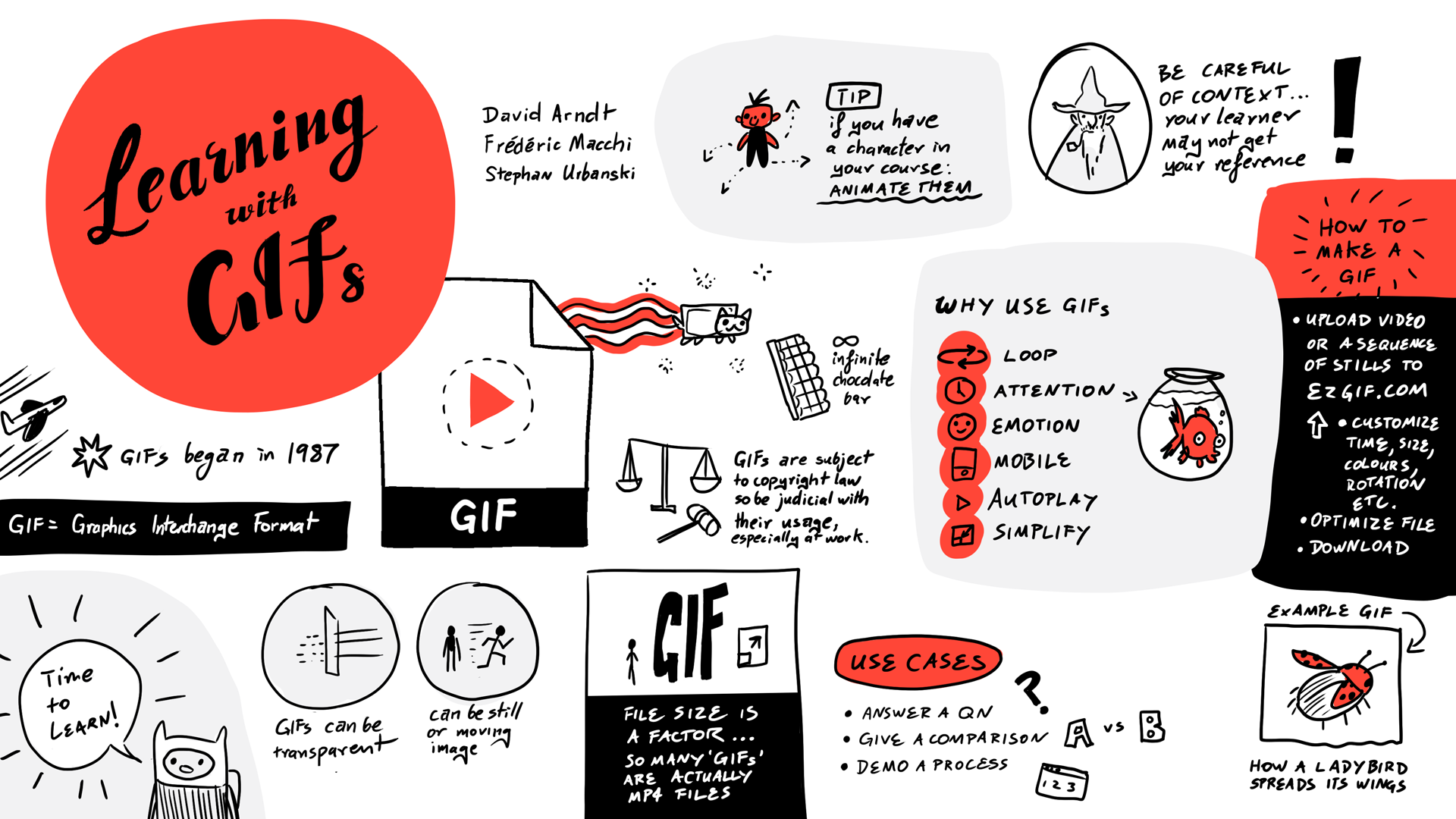
Contact person

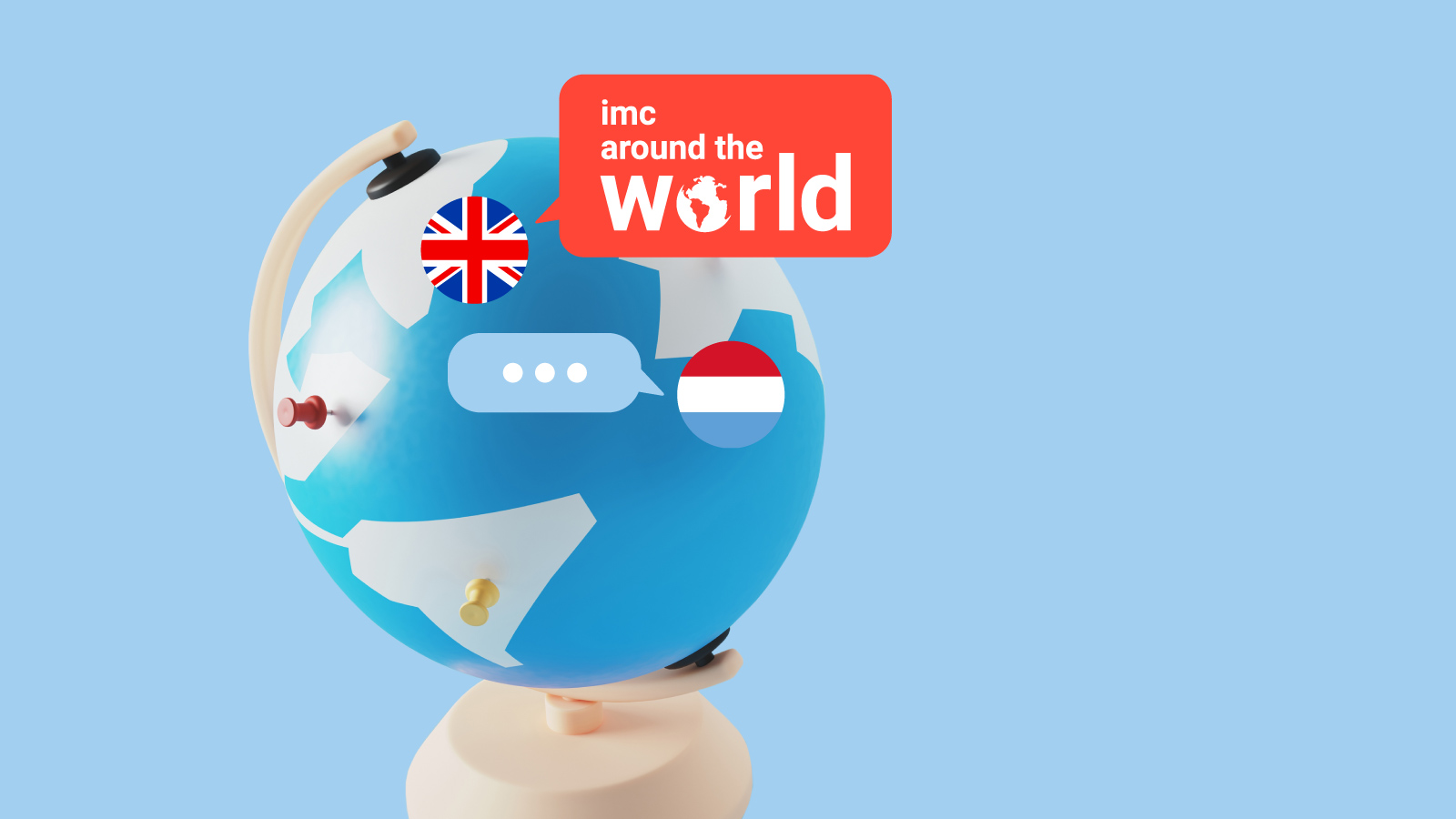
The future of Corporate Learning 2021
L&D was heavily impacted by COVID-19 last year. But there is always a light at the end of every tunnel. “With massive disruption comes massive opportunity. I've seen many organisations rethinking their business model with digital learning becoming an enabler to help them extend reach, drive new channels or implement new business approaches”, says Russell Donders, Director International Markets.
Nick Spielkamp, Senior Sales Manager at imc Switzerland and Daniel Antman, Managing Director imc Australia have already talked about incredible opportunities such as "Learning Analytics" or "Aligning Learning Strategies to The Digital Generation" in our last two episodes of this article series. But what is the situation like in other countries? For example in the United Kingdom, the Netherlands and Belgium? Tracey Blamire (Business Development Manager UK) and Tanja Baars (Business Development Manager Netherlands & Belgium) share their experiences and what to expect for the future of corporate learning in 2021.

Tracey Blamire, imc
Last year, almost all classroom trainings were forced to switch to virtual classrooms, practically overnight. Some organisations dealt (surprisingly) well with the sudden change. Others, not so much.
Aside from the technical challenges and people’s ability to find the (un)mute button, it also led to (social) interaction and attention challenges. Many teachers have struggled with getting and holding the same level of attention as they were used to in a physical classroom.
Interacting with learners became (even) harder and many teachers found themselves desperately checking their sound settings during the umpteenth awkward silence after asking a question. Are learners holding back in a virtual environment? Are they more easily distracted? Or are they just paying less attention when they’re not physically in the same room as their teacher and fellow learners?
As the virtual classrooms are here to stay (even when the physical classrooms will have returned), these interaction and attention challenges will be the 2021 nuts to crack. I think many players in the elearning industry will throw themselves on this issue. Tech companies will come up with dazzling new features, learning content providers will develop even more engaging and interactive content and teachers will invent creative new ways of motivating and encouraging their learners. I’m convinced that all their efforts in combination with a naturally growing adaptation of virtual environments in general, will – in the end – put an end to the awkward silences.
Happy new year!

Tanja Baars, imc
It’s safe to say that no organisation had planned the fast-forward digital transition that they went through in 2020. Some organisations had to speed up the process that they were already in, others suddenly had to start from scratch.
The speed of the 2020 digital transition was pretty impressive, sometimes surprising, but in some cases quite tricky, too. Organisations were forced to take decisions overnight, often without thoroughly researching their actual (long-term) needs.
Blinded by short term necessities and the need for speed, time became a disproportionately big factor in the decision and implementation process.
Obviously, in such unprecedented circumstances, there is no one to blame for that (although, if you hadn’t even started your organisation’s digital transition before Covid, there actually might be people to blame, but that’s another discussion), but many organisations will probably have to deal with the consequences after the pandemic.
I think many organisations will only realise in 2021 that some long-term needs were overlooked during the speedy transition process in 2020. Especially factors that make digital (learning) platforms not only pandemic-proof but also future-proof – like the platform’s ability to scale and adapt to future changes and growth of the organisation – might have been forgotten in hasty times in which everything was Covid.
I genuinely hope that I’m wrong, and that, in a few years’ time, we can conclude that the accelerated processes during the pandemic actually had a positive and durable outcome for organisations in the long run. Let’s stay positive. And Covid-negative.
Happy 2021!
Contact
I’ve been a member of the imc crew since February 2019. My multi-faceted tasks always keep me on the go. In addition to my work on corporate brand, marketing and communication strategies and employer branding, I also delve into the operational side.
I have a passion for networks and communities. That is why I represent the brand ambassador programme in the editorial team. I am also actively involved in the SCHULEWIRTSCHAFT (School-Business) network.
Privately, my big passions are travelling, Disney and interior design.

![[E-Learning Punk] Christmas Special](https://images.im-c.com/wp-content/uploads/2020/12/imc_image_elearningpunk_Christmas_hero_2020_12_17.jpg)
Punky Talk #5: Sven R. Becker
The imc Board Member talks about basics like learning culture and target group orientation
Our fifth Punky Talk is our 2020 Festive Season Special. As a one-off, it is dedicated to the e-learning basics rather than to trends. After all, countless lists of top trends for the coming year are popping up wherever you look. We would rather use the year-end to ask: What are the fundamentals companies need to have in place before they can focus their efforts on the latest digital professional development trends in 2021?
And who is better placed to answer this question than Sven R. Becker? Sven was appointed to the Management Board of imc in January 2019 after many years of service for the company. During his studies, Sven already worked intensively on e-learning and UX design. Having paid close attention to the developments in the industry for years, he noted: 2020 was not just the year of corona, but also the big moment for “digital literacy”. A digital mindset now exists pretty much everywhere. Consequently, the relevance of e-learning is no longer limited to large corporations and companies in heavily regulated industries.
Sven recommends that anyone seeking to venture into the digital professional development world in the new year take an iterative approach. The important thing now is to get started! When trying to decide whether or not a trend is useful for your company, Sven suggests taking a closer look at the target group.
Sven also talks about costs, grassroots movements and the impact e learning has on corporate success.
Enjoy watching!

To watch this video, marketing cookies must be accepted. Click on the play button to accept. You can find more information in our cookie banner and in the privacy policy.
(Note: under "settings", you can turn on the English subtitles for this interview)
Contact person


Corporate Learning 2021:
Looking to the future – right now
2020 was an exceptional year – shaped by a global pandemic, it will undoubtedly remain in our collective memory for a very long time to come.
We have talked a great deal about what this crisis means for digitalisation. Is it a driver or an inhibitor? Where are the hidden champions? Do we have an appetite for digital fast food, or do we hunger for slow food?
Of course, not every company was prepared to grab the bull by the horns, but digitalisation has been shown to ensure a company's survival while opening up new possibilities as well. In addition to new markets, business models and target groups, professional development has certainly taken on a key role this year.
These are exciting times for Learning and Development Professionals, as in-person training sessions, which had generally been the norm up until the crisis, now present new challenges for organisations. It's time to rethink professional development! We are experiencing an unforeseen demand for online formats and learning platforms, as well as a need to create hybrid formats; for example, social learning has suddenly transcended the limits of likes and comments.
In this series of articles, however, we will not be looking back but rather setting our sights on the future. While imc experts from around the world share their experiences from last year in a four-part special feature, they are primarily looking forward to new topics, trends and opportunities.
This special feature is meant to provide encouragement as well as ideas and impulses for the coming year. Nick Spielkamp, Head of Marketing and Sales at imc Switzerland will kick the series off with Part 1.

Nick Spielkamp, imc
In the upcoming year, digital training initiatives in Switzerland will focus strongly on actual business output. The current crisis will continue to be a driver for digital learning in 2021, but the effect of all training measures on the enabling of employees will be monitored even more closely, so that training budgets can be used accordingly.
So I see a strong shift from a pure training focus to a strong performance focus. In order to be able to substantiate the effects on the optimization of work results, the consolidation of training and business data in the form of Learning Analytics analyses will play a central role in the coming year.
Learning Analytics data not only provides evidence of the effectiveness of training measures, but also allows for targeted intervention in training to further optimize it and ultimately make employees better at what they do.
In addition to the continuous sharpening of digital training measures in terms of business output, I see a strong decentralization of the design and production of digital training content in the coming year. The Corona crisis has further reinforced the trend that more and more learning content must be digitized in the shortest possible time.
This cannot be achieved by the professional learning and development departments in the companies alone, which is why the technical experts themselves are increasingly assuming responsibility at this point.
However, these know-how carriers must be enabled accordingly in order to create didactically and visually high-quality training courses for various output formats at a reasonable cost. This is exactly where new types of rapid authoring solutions will play an important role, supporting the subject matter experts with artificial intelligence in the efficient production of digital learning content.
Contact
I’ve been a member of the imc crew since February 2019. My multi-faceted tasks always keep me on the go. In addition to my work on corporate brand, marketing and communication strategies and employer branding, I also delve into the operational side.
I have a passion for networks and communities. That is why I represent the brand ambassador programme in the editorial team. I am also actively involved in the SCHULEWIRTSCHAFT (School-Business) network.
Privately, my big passions are travelling, Disney and interior design.


Shaping the new world of Corporate Learning in 2021
Our series of articles from imc employees all over the world started in Switzerland. In this episode we take you to the other side of the world. Daniel Antman, Director imc Australia, has joined imc in February 2020 and had to face special challenges right from the start. In this guest article he talks about his experiences, lessons learned but also chances and possibilities for the Australian e-learning marketing in 2021.

Daniel Antman, imc
The digital transformation of learning is having an immediate and notable impact on business performance. Companies will need to redefine their organisation’s learning and development strategy in 2021 to ensure alignment with their revenue and growth objectives.
As we approach the end of what can only be described as a tumultuous 2020 and look forward to 2021, the dominant behaviours that will define success are adaptability, nimbleness and alignment.
Many businesses are going through their 2021 strategic planning right now and some who may have already completed their plans, are going back to revisit them to ensure they are relevant to the probable long-term structural changes we have seen.
From a macro perspective we see a relatively stable outlook for both Australia and New Zealand. We have a well-capitalised banking sector that has proven its resilience in throughout both the global financial crisis and more recently through the pandemic.
At the national levels both economies have relatively low debt levels to GDP (compared to other western economies) ensuring there are tools in the fiscal cabinet for government (Federal and State) to implement stimulus programs to keep the economy moving. We have unprecedented low interest rates that have kept both consumer spending and the housing market at acceptable levels throughout this 2020 Covid impacted year.
We have also not yet seen the expected spike in unemployment. While the expectation is that the peak in unemployment won’t be seen until Q1 2021, there is a quite confidence it may not be as bad as originally predicted. The jobkeeper program (a federal government initiative that has ensured workers impacted by a shut-down in their sectors retain an income) has steadied the economic ship and minimised the impacts of the covid shut-downs.
Perversely we think there may be upside in the dislocation of people from their traditional jobs and professions as they potentially return to the workforce in different industries. The movement of people into new roles and businesses should in theory bring into focus the need for more and effective training.
We have seen a significant uptick in employment with some of our clients in the public sector who have absorbed a number of displaced workers. For example, we have seen a consistent increase in demand for our content services from DHHS (Department of Health & Human Services) who have been actively expanding throughout the covid crisis.
There is also a sense the language of business is changing. A few months ago people in business were still saying “when things go back to normal we’ll do this and that”. Now the rhetoric is changing.
There is greater recognition, at least empirical recognition, that we are probably going to be forever spinning on a new axis. Think back to the 2011 powerful earthquake that moved the main island of Japan by 8 feet and shifted the Earth on its axis. It’s where we are at in terms of the business landscape too – spinning in a different place and probably never going back.
We also rethinking the way businesses are segmented in Australia/New Zealand corporate market. While businesses can be easily bucketed into defined categories, for example financial services or utilities, from a learning perspective we see them grouped differently. Specifically, we see the local corporate landscape being defined as entities that are:
- Membership orientated (e.g professional associations like ACCA and AusIMM)
- Exposed (e.g those heavily impacted by regulation/compliance like financial institutions)
- Complex (e.g dynamic entities who requires a deep and complex solutions that brings their organisation together like a pharma business)
- Challenged (e.g Organisations who have experienced significant and complex growth pains and have been forced to evolve due to late adoption)
- Branded (e.g Organisations who have a brand promise to uphold and deliver like Blackmores)
It is true that an entity may take on more than one of the above characteristics yet they typically have a bias to one. The importance of understanding this in the Australian context is that learning and development will mean different things to entities where there are different bias’s. That requires our communication, business development and marketing to be bespoke and identifiable to them.
Within each of these business personas are the decision makers and, when it comes to aligning the concept of learning with business objectives, they will be motivated by different things. While these are not new concepts (in terms of how decision makers can be categorised), we are seeing the emergence of clearer definitions of who the decision makers are in the types of organisations noted above.
In other words, it’s a bit of a match-and-mix matrix between the type of organisation and the decision makers. As the concept of employee development, training and motivation in a remote working environment continues to unfold, decision makers will need to be swayed by targeted and relevant messaging about the role of learning and how the empowerment of their people is directly connected to business performance.
These decision makers can be broadly classified as one of:
The Charismatic - decision makers with big ideas and proven results that speak to the bottom line and keep my company competitive.
The Thinker - Intelligent, low-risk solutions that save time and money.
The Sceptical - Ground-breaking ideas with people I can trust.
The Follower - The best ideas have been tried and tested by big brands.
The Controlling - Highly structured arguments that fit like a glove.
Adaptability and Speed Are Key

We’ve seen many examples of businesses having to adapt to this new business as ‘unusual’ environment. In a learning context, we’ve seen companies pivoting from delivering in-house training sessions, offsite sales conventions and other forms of in-person professional development to a full digital delivery format.
Those who have adapted quickly may well be best positioned to capitalise on the ongoing benefits of digital learning. It’s one thing to adapt, it’s another thing to do it efficiently and effectively. Again, in a learning context, those businesses who have been fast and adept at embracing new delivery mediums are having more success in maintaining effective connections with staff and key stakeholders.
Aligning Learning Strategy to The Digital Generation
Aligning the delivery of quick, effective and meaningful knowledge-transfer with the commercial/performance imperatives of the business has never been more critical. For many astute business people, the current climate has highlighted the critical importance of knowledge transfer and learning to drive increased engagement with staff and other stakeholders including customers.
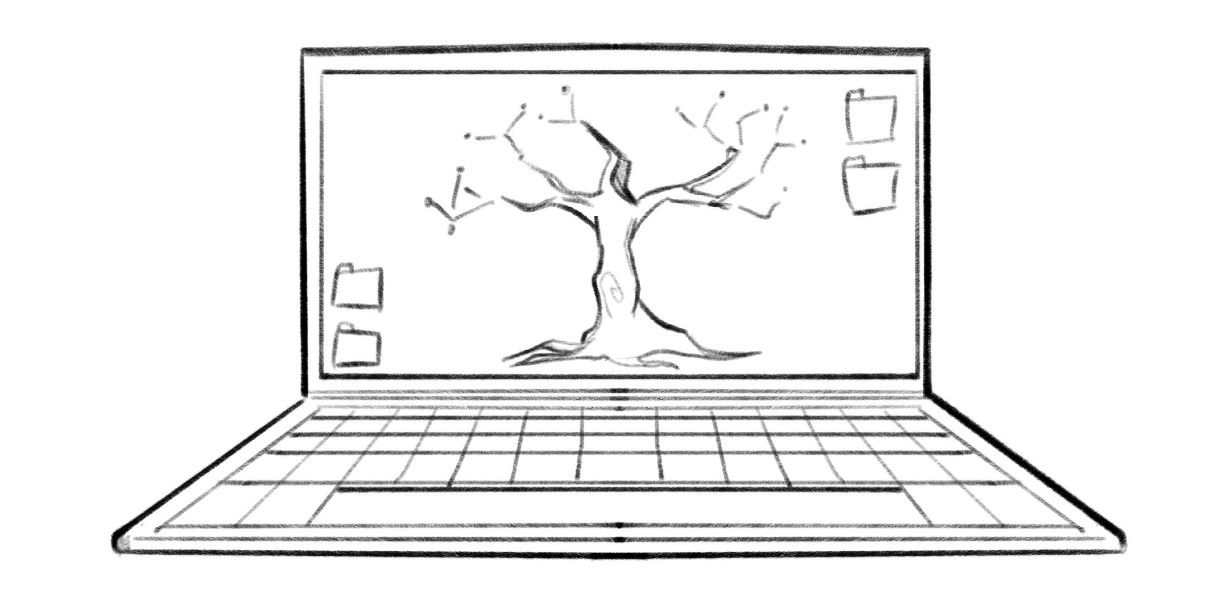
Stable, well trained and stimulated employees translate directly to the bottom line. Well-developed and informed customers/stakeholders become advocates for businesses.
A recent LinkedIn research study identified the primary driver that connected Millennials and Gen Zs to the organisations they worked for was development. Not pay or work conditions, but development.
For organisations who see themselves as genuine learning businesses, and who are committed to developing and growing their teams, their time has come. They are embracing the technologies that will enable them to deliver the learning that is valued by those seeking the development, support and care.
Happy, stimulated, developing and supported employees are those more likely to stay and contribute to ongoing success - something every C-Suite and/or senior manager needs to keep in mind.
Virtual Conferencing Tools and Learning

Throughout the crisis of 2020 businesses have turned to and utilised connectivity tools including Zoom, GoToMeeting and Teams to mention a few. In many respects these tools have been a communication lifeline for business. Yet on their own they are not learning, training or development tools.
Genuine learning that is impactful, sustainable and measurable needs to be expertly designed to ensure it delivers the desired outcomes through the chosen delivery platform. Virtual conferencing tools can and often do play an important part in a blended learning environment. However, they are not designed to be alternatives to expertly designed and delivered learning platforms.
Would You Like Cake & Coffee with Your Training?
Are those days gone? No longer can businesses rely on the attraction of food and drink to encourage staff to join the in-house training sessions in the communal meeting rooms. Nor can they rely on trips to the local café which doubled up as the overflow meeting room when the office facilities were booked.

Yet the challenges that 2020 have thrown out open the opportunity for innovation and out-of-the-box thinking when it comes to learning. The sophistication and power of technology driven learning platforms offer businesses with exciting possibilities to deliver knowledge in a way that can be a genuine game-changer.
Learning, training and knowledge-transfer are no longer the sole domain of the HR or Learning Development teams. They should be a focal point for the C-suite and boards when considering how to leverage digital learning platforms to develop, stimulate and ultimately retain the people they rely on to meet their business objectives.
Contact
I’ve been a member of the imc crew since February 2019. My multi-faceted tasks always keep me on the go. In addition to my work on corporate brand, marketing and communication strategies and employer branding, I also delve into the operational side.
I have a passion for networks and communities. That is why I represent the brand ambassador programme in the editorial team. I am also actively involved in the SCHULEWIRTSCHAFT (School-Business) network.
Privately, my big passions are travelling, Disney and interior design.

Learning and connection for the future
What companies should consider in 2021 – part 2
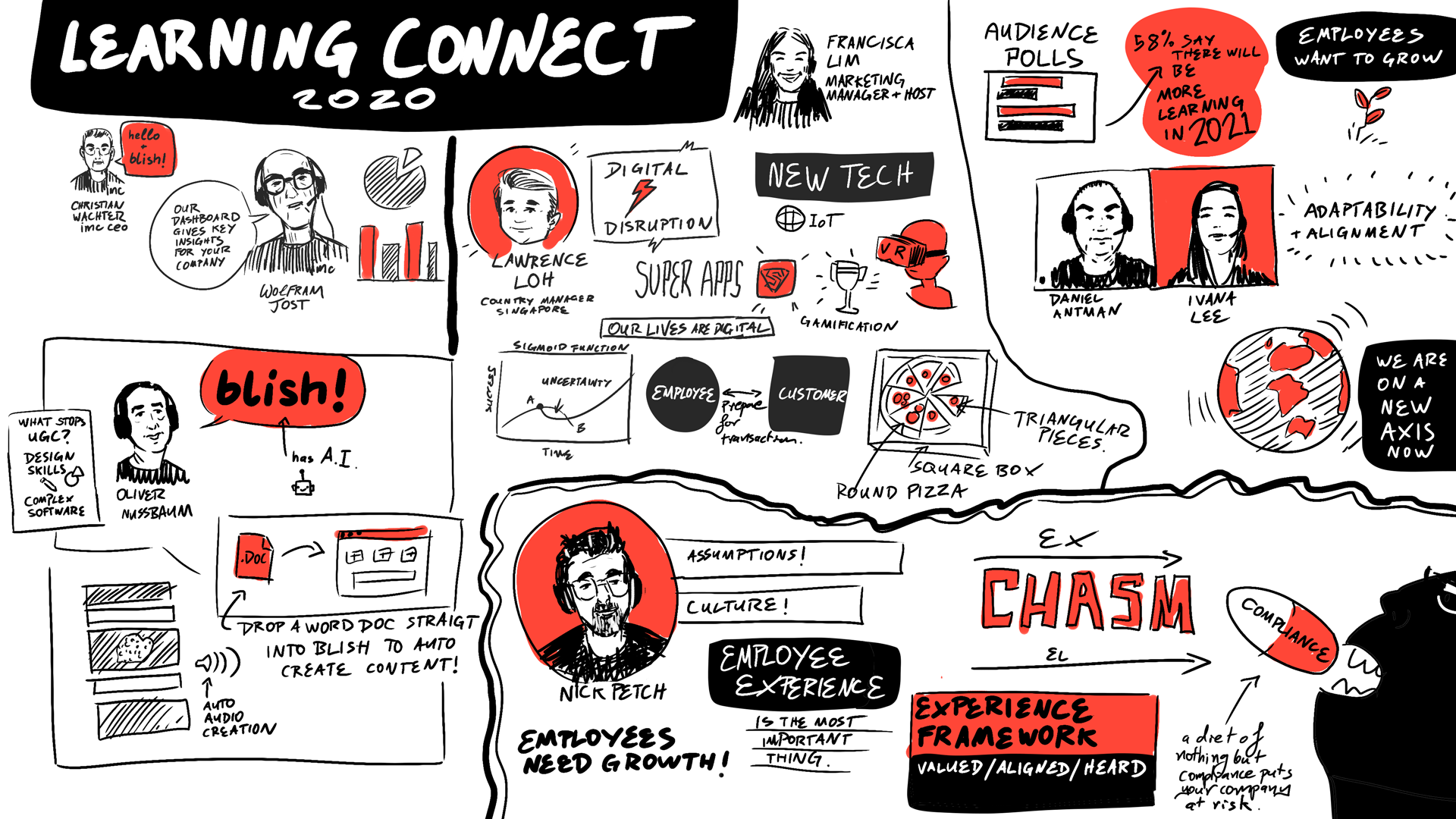
Sketchnote by Adam van Winden, imc
Less staff fluctuation by considering employee experience
Redesigning organisations’ employee experience was the focus in Nick Petch’s session. Nick, who heads the Digital Learning Experience & Design Strategy team, pointed out that employee experience is a powerful way to improve organisational learning and, ultimately, the future of performance.
But not many organisations consider employee experience as an essential aspect in the learning and development process. And employee experience isn't just about creating a great experience, it's about establishing a culture and identity of learning and development that is fundamental for an organisation's success.
Every step in the employee journey from onboarding, induction and development will influence an employee’s perspective towards the organisation. When organisations don't design each of these steps carefully, employees will feel that they are not valued, which will lower staff retention rates.
Experience or designing for experience is a systemic design challenge and not a single event. Developing an experience framework represents the very first step of an employee experience.
Platforms should work for the user – not vice versa
The panel discussion with Daniel Antman, Managing Director Australia and Ivana Lee, Managing Director Asia, was about measuring results of learning and development objectives. Both agreed that creating meaningful content, where the platform works for the learners rather than the other way around, is vital to ensure that learners can feel the benefit of a Learning Management System (LMS).
In the session, the speakers also pointed out that things are not going back to normal. Adaptability, nimbleness and alignment are the steps that need to be implemented by organisations to stay competitive. For organisations that see themselves as genuine learning businesses, and who are committed to developing and growing their teams, their time has come. They are embracing the technologies that will enable them to deliver learning that is valued by those seeking the development, support and care from businesses committed to them.
Training is not the same as development!
Within the discussion, the presenters also answered thoughtful questions from participants. Questions came across on topics like:
- when to start redesigning the employee experience
- how to prepare the workforce with the right skills in the current situation
- the availability of imc Express
Concerning imc Express, which will be rolled out in 2021, the speakers emphasised that this tool will not replace imc Content studio.
Besides this, there was a question if learning analytic dashboard is a part of LMS. However, this is not the case. Learning Analytics dashboard will be a separate component; it will extract the data from LMS and the business data to produce the result.
The difference between training and development was also raised. This was explained as training is a set of programs defined by an organisation and development being much more an entrepreneurialistic, where people are motivated to learn and to improve by themselves.
Participants polls
Participants had the option to vote in several surveys. The result:
- 50% of the audience were excited with the upcoming challenges in 2021.
- 41% expect that organisations will be doing more learning and development in 2021.
- 58% think that their organisations learning and development objectives are aligned with the commercial or performance urgency.
We would like to thank all our customers, but also the whole organisational team for this great event and we hope to see you again next year - may it be in person or digital!

Further information
Click here to watch the recording of the Learning Connect Session.
Learn more about the Learning Management System imc Learning Suite.
Contact


Learning and connection for the future
What companies should consider in 2021 – part 1
How can organisations and employees survive the accelerating of the digital transformation? This is a global challenge that all industries are facing nowadays and which they can only handle by focusing on learning and training. Especially the last months has opened the eyes of CEO's, CHRO's and Heads of Learning to an even more significant opportunity for reskilling and retraining. Therefore, it’s essential to use the right platform to launch into future growth and to ensure staff retention.
These were the most important themes of imc Learning Connect industry event which was organised by imc Asia and took place virtually on 24 September 2020. We summarised the key facts of the event and which topics Learning and Development professionals, learning enthusiasts and digitalisation fans should have on their watch list for the upcoming year in two series of articles. This is the first of the series.
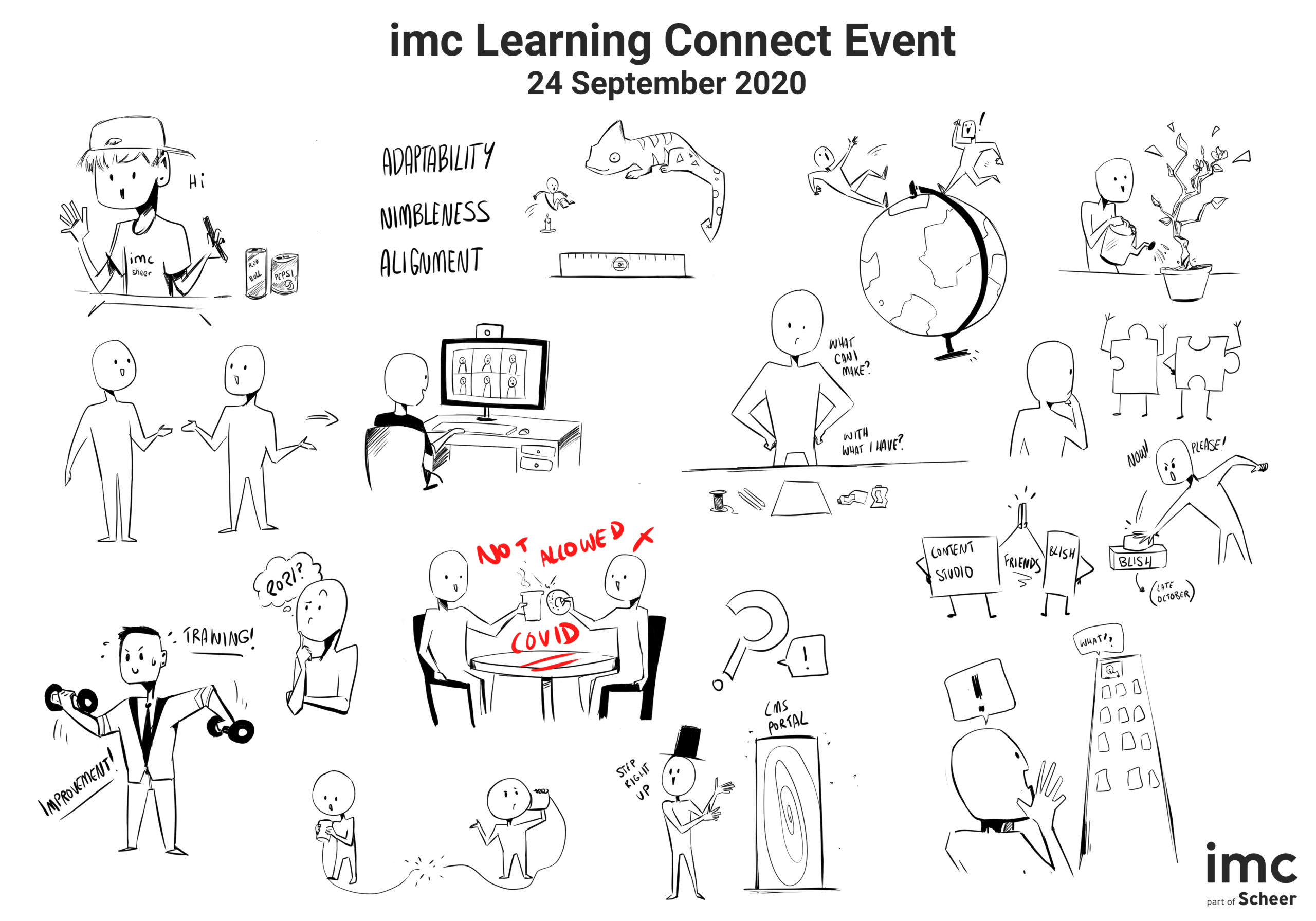
Sketchnote by Felix Macfarlane, imc
Redesigning employee experience
Christian Wachter, CEO of imc, opened the event and shared an outlook on the upcoming sessions. Among others, he talked about the importance for organisations to improve their learning strategy by utilising learning analytics dashboard. He also pointed out how to redesign employee experience to encourage lifelong learning and introduced imc’s new authoring tool called blish!. He closed his presentation with the hint, that technology is only a tool to transform organisations digitally; nevertheless, the input is much more critical to ensure effective utilisation.
Learning analytics and business outcome
In the maximise Learning Outcomes Session, imc board member Dr. Wolfram Jost discussed the importance of measuring the result of Learning and Development and how these will impact the business performance. With a learning analytics dashboard, organisations can see the link between the learning program and business key performance indicators.
Proving this connection can be a great support in convincing the management: When learning and development leaders could show the impact of their program, management shall be more convinced to invest in reskilling and retraining.
Digital transformation – but how?
How can digital learning support companies on their process of digital transformation? That was the topic of Lawrence Loh, Country Manager of imc Singapore. He pointed out that digital literacy, access and participation are essential to optimise organisations digital competency, as all these points influence future skills, business transformation and innovation as well as job profiles. Transferred to organisations, this means they have to prepare for the acceleration of digital led trends in order to optimise organisations digital competency.
Digital enterprise organisations will need to combine their processes, technology and people in the path towards digital transformation. To speed up this process will only be possible with digital learning and therefore a Learning Management System with a good user interface and user experience will enhance the learners' potential.
Creating learning content has never been that easy
User generated learning content is the topic in imc Express, an authoring tool session by Oliver Nussbaum. Everybody can produce a learning content since people has abundance knowledge they could share within their organisations. Functional understanding of software, awareness of good design and basic didactical knowledge are the skills required to be learning content producer. imc Express will support the creation of meaningful learning content with a strong Artificial Intelligence (AI); hence everybody could publish their knowledge.
That was part one of the event highlights, you can find the second part here!
Further information
You would like to learn more? Here you can find out more about the content authoring tool imc Express.
Or watch the event recording here.
Contact

